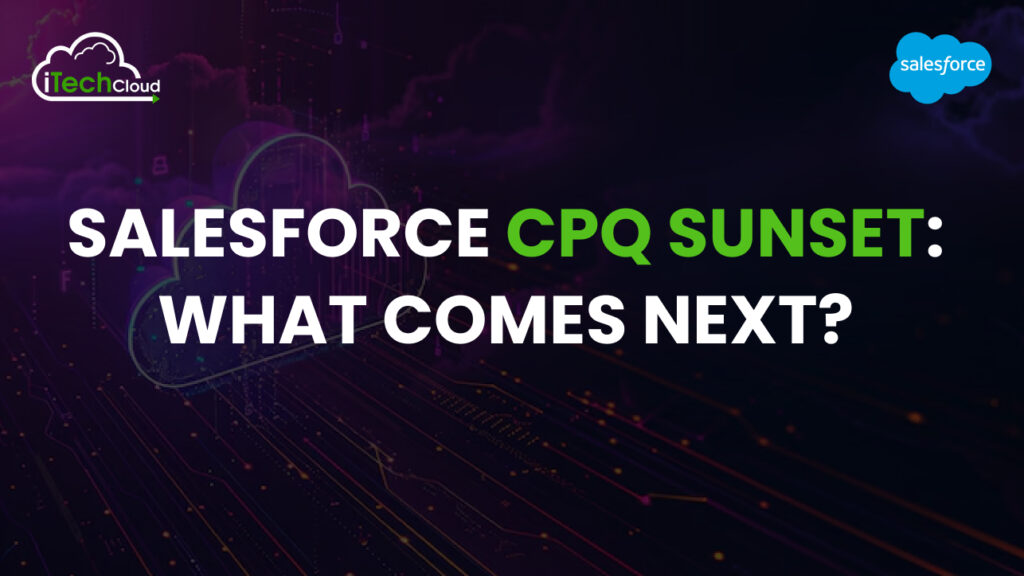Salesforce CPQ Sunset: What Comes Next?

Introduction
Salesforce CPQ (Configure, Price, Quote) has long been a critical tool for businesses looking to automate and optimize their sales quoting processes. However, recent shifts in Salesforce’s product strategy, including the integration of CPQ into Revenue Cloud, have led many to question whether traditional Salesforce CPQ is being sunsetted or significantly transformed.
Table of Contents
By the end, you’ll have a clear understanding of your options and how to ensure your quoting processes remain efficient in a post-Salesforce CPQ landscape.
Why Is Salesforce CPQ Changing?
Salesforce acquired SteelBrick in 2015, rebranding it as Salesforce CPQ, and positioned it as a key component of its sales automation suite. However, recent developments suggest a shift in strategy:
1. Integration into Revenue Cloud
Salesforce is consolidating CPQ with Billing, Subscription Management, and Revenue Recognition under Revenue Cloud, signaling a move toward a more holistic revenue operations platform rather than a standalone CPQ tool.
2. The Rise of AI and Advanced CPQ Solutions
Legacy CPQ tools struggle to keep up with modern demands for:
- AI-driven pricing
- Dynamic discounting
- Subscription and usage-based billing
Salesforce may be pushing users toward Revenue Cloud or third-party solutions that better support these features.
3. Competitive Pressure from Specialized CPQ Vendors
Solutions like DealHub, Oracle CPQ, and Apttus (Conga CPQ) now offer deeper functionality, better UX, and stronger AI capabilities, making traditional Salesforce CPQ less competitive.
4. Salesforce’s Focus on Industry-Specific Solutions
Instead of a one-size-fits-all CPQ, Salesforce is tailoring solutions for industries like financial services, healthcare, and manufacturing within Revenue Cloud.
Is Salesforce CPQ Really Being Sunset?
While Salesforce hasn’t officially announced a sunset, the shift toward Revenue Cloud suggests that the traditional CPQ product may no longer be the primary focus. Businesses should prepare for a transition.
Top Alternatives to Salesforce CPQ
If you’re considering a move, here are the leading CPQ solutions in 2025:
1. Salesforce Revenue Cloud (Next-Gen CPQ)
✅ Pros: Native Salesforce integration, end-to-end revenue lifecycle management.
❌ Cons: May lack some advanced CPQ features; pricing can be complex.
🏆 Best for: Enterprises deeply invested in Salesforce.
2. DealHub CPQ
✅ Pros: AI-powered, intuitive UI, seamless Salesforce sync.
❌ Cons: Less suited for highly complex manufacturing configurations.
🏆 Best for: Mid-market and SaaS companies.
3. Oracle CPQ Cloud
✅ Pros: Extremely robust for complex product configurations.
❌ Cons: Expensive, steep learning curve.
🏆 Best for: Large enterprises with intricate pricing models.
4. Apttus CPQ (Now Conga CPQ)
✅ Pros: Strong Salesforce integration, good for CLM (Contract Lifecycle Management).
❌ Cons: Post-acquisition roadmap uncertainty.
🏆 Best for: Companies needing CPQ + contract automation.
5. Pros of CPQ
✅ Pros: Strong AI and dynamic pricing capabilities.
❌ Cons: Smaller market presence.
🏆 Best for: Businesses prioritizing AI-driven sales.
6. FPX SmartCPQ
✅ Pros: Excellent visualization tools for manufacturing.
❌ Cons: Limited brand recognition outside industrial sectors.
🏆 Best for: Manufacturing and engineering firms.
7. Configure One (Revalize)
✅ Pros: Great for complex product bundles.
❌ Cons: Weaker Salesforce integration.
🏆 Best for: Engineering and B2B product companies.
Key Considerations When Migrating from Salesforce CPQ
Before choosing a new CPQ, evaluate:
1. Integration Capabilities
- Does it sync with Salesforce, ERP (NetSuite, SAP), and billing systems?
- Can it support e-signature tools (DocuSign, Adobe Sign)?
2. Pricing & Scalability
- Is it cost-effective as your business grows?
- Are there hidden fees for additional features?
3. AI & Automation
- Does it offer predictive pricing, guided selling, or automated approvals?
- Can it handle real-time pricing updates?
4. User Experience
- Is the interface easy for sales reps to use?
- How much training is required?
5. Customization & Flexibility
- Can it support subscriptions, global pricing, and complex discounts?
- Can non-technical users modify rules?
6. Vendor Stability
- Is the vendor financially healthy?
- What’s their product roadmap?
Best Practices for a Smooth CPQ Migration
1. Audit Your Current CPQ
- Document all workflows, pricing rules, and integrations.
2. Define Must-Have Features
- List non-negotiable features (e.g., multi-currency, approval workflows).
3. Run a Pilot Test
- Test the new CPQ with a small sales team before full rollout.
4. Train Your Teams
- Provide hands-on training to ensure adoption.
5. Monitor Post-Migration Performance
- Track quote turnaround time, win rates, and errors.
The Future of CPQ: 5 Key Trends
- AI-Powered CPQv – Predictive pricing, automated approvals.
- Subscription & Usage-Based Pricing – More flexible billing models.
- No-Code CPQ Customization – Sales ops can modify rules without IT.
- CPQ + CLM + Billing Convergence – End-to-end revenue platforms.
- Self-Service Quoting Portals – Buyers configure their own deals.
Conclusion: Salesforce CPQ Sunset
Salesforce CPQ sunset marks a pivotal shift for users, urging migration to Salesforce Revenue Cloud or alternative CPQ solutions. While change can be challenging, it brings opportunities to modernize quoting, billing, and subscription processes with enhanced automation and AI-driven insights. Businesses should evaluate their needs, explore migration paths, and leverage Salesforce’s support for a smooth transition. Embracing this evolution ensures future-ready sales operations, improved scalability, and deeper CRM integration.

